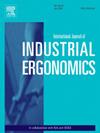Analysis of driver's physiological responses and task load in curved and spiral tunnels: A naturalistic driving experiment
IF 2.5
2区 工程技术
Q2 ENGINEERING, INDUSTRIAL
International Journal of Industrial Ergonomics
Pub Date : 2024-11-01
DOI:10.1016/j.ergon.2024.103664
引用次数: 0
Abstract
This study aims to analyze the physiological responses and task load of drivers in curved and spiral tunnels. Spiral tunnels, a unique solution for complex terrains, exhibit distinct geometric and functional characteristics compared to curved tunnels. Despite advances in spiral tunnel design in China, concerns about driver safety persist. The research recruited 30 participants to conduct naturalistic driving experiments in curved and spiral tunnels. By analyzing heart rate variability (HRV) indices and using factor analysis, four HRV indices (HR, SDNN, LF/HF, SampEn) were selected as primary indicators. Results from statistical analysis showed that drivers had a significantly higher average heart rate (HR) in spiral tunnels compared to curved tunnels (F(1,1198) = 593.29, p < 0.01), indicating greater psychological stress and physiological burden. The standard deviation of NN intervals (SDNN) was lower in spiral tunnels (F(1,1198) = 868.18, p < 0.01), suggesting reduced heart rate variability and a more dominant sympathetic tone. The ratio of low-frequency power to high-frequency power (LF/HF) was higher in spiral tunnels (F(1,1198) = 419.85, p < 0.01), indicating increased sympathetic nervous system activity. Additionally, the sample entropy (SampEn) of the electrocardiogram was lower in spiral tunnels (F(1,1198) = 1595.05, p < 0.01), suggesting a decrease in the complexity of the ECG signal and a weaker autonomic nerve regulation ability of the heart. Subjective task load evaluation using the NASA-TLX scale further revealed that drivers experienced a higher task load across various dimensions such as mental demand, physical demand, temporal demand, effort, frustration, and performance in spiral tunnels. In summary, this study provides valuable insights into the physiological and psychological responses of drivers in curved and spiral tunnels, contributing to optimizing tunnel design, improving driver education and training, and enhancing tunnel safety and the overall driving experience.
分析弯道和螺旋隧道中驾驶员的生理反应和任务负荷:自然驾驶实验
本研究旨在分析驾驶员在曲线隧道和螺旋隧道中的生理反应和任务负荷。螺旋隧道是应对复杂地形的一种独特解决方案,与曲线隧道相比,螺旋隧道具有独特的几何和功能特征。尽管中国在螺旋隧道设计方面取得了进步,但对驾驶员安全的担忧依然存在。研究招募了 30 名参与者,在弧形和螺旋形隧道中进行自然驾驶实验。通过分析心率变异性(HRV)指数,并使用因子分析,选择了四个心率变异性指数(HR、SDNN、LF/HF、SampEn)作为主要指标。统计分析结果表明,与曲线隧道相比,驾驶员在螺旋隧道中的平均心率(HR)明显更高(F(1,1198) = 593.29, p <0.01),表明心理压力和生理负担更大。螺旋形隧道的 NN 间期标准偏差(SDNN)更低(F(1,1198) = 868.18,p <0.01),表明心率变异性降低,交感神经张力更强。低频功率与高频功率之比(LF/HF)在螺旋隧道中更高(F(1,1198) = 419.85, p <0.01),表明交感神经系统活动增加。此外,螺旋隧道中心电图的样本熵(SampEn)较低(F(1,1198) = 1595.05, p <0.01),表明心电信号的复杂性降低,心脏的自律神经调节能力减弱。使用 NASA-TLX 量表进行的主观任务负荷评估进一步显示,驾驶员在精神需求、体力需求、时间需求、努力程度、挫败感和螺旋隧道中的表现等多个维度上都经历了较高的任务负荷。总之,本研究为了解驾驶员在弯道和螺旋隧道中的生理和心理反应提供了宝贵的见解,有助于优化隧道设计、改进驾驶员教育和培训、提高隧道安全性和整体驾驶体验。
本文章由计算机程序翻译,如有差异,请以英文原文为准。
求助全文
约1分钟内获得全文
求助全文
来源期刊
CiteScore
6.40
自引率
12.90%
发文量
110
审稿时长
56 days
期刊介绍:
The journal publishes original contributions that add to our understanding of the role of humans in today systems and the interactions thereof with various system components. The journal typically covers the following areas: industrial and occupational ergonomics, design of systems, tools and equipment, human performance measurement and modeling, human productivity, humans in technologically complex systems, and safety. The focus of the articles includes basic theoretical advances, applications, case studies, new methodologies and procedures; and empirical studies.

 求助内容:
求助内容: 应助结果提醒方式:
应助结果提醒方式:


